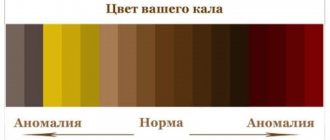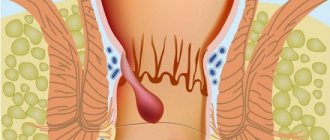A change in the color of stool can indicate many physiological and pathological processes in the body. The color of stool is affected by diet, chronic diseases and various intestinal pathologies.
Monitoring the quality of stool can be important for self-diagnosis. Many mothers complain that their baby has black stool. Such changes can occur for several reasons.
Basic information
Black stool can be a serious symptom
People often pay attention to the nature of their discharge. A change in the color of urine or stool often causes alarm and is a reason to consult a doctor. Normal stools are brown in color because the stool contains bile residues.
If food is digested faster than expected, the stool may acquire a greenish tint due to insufficient decomposition of bile. White stool may indicate blockage of the bile ducts.
In medical practice, black tarry stools are primarily associated with hemorrhage in the esophagus or stomach. The fact is that the blood released in the upper parts of the digestive tract undergoes chemical decomposition during the digestion of food.
It takes a long time before such blood reaches the rectum. As a result, the blood turns black. In contrast, blood released in the lower intestines will have a characteristic bright red color.
Fortunately, bleeding is not the most common cause of dark stool. This color can be the result of food eaten, metabolic characteristics, or diseases. However, any change in a child's stool should be a reason for diagnosis, since the health of the digestive system is of primary importance for a growing organism.
Normal baby stool
A breastfed baby's stool is yellow or slightly green and has a soft texture. It can be quite liquid, with a consistency similar to porridge. There are many normal shades of baby stool. One of them is a greener tint, which means that mom ate something not entirely typical of her diet. When your baby has no other symptoms, there is no reason to worry.
As a rule, every parent knows what stool color is normal for their child. Therefore, when the stool becomes unusual, it is impossible not to notice.
Symptoms of various conditions
Food also affects the color of stool
Black stool may not be the only sign of a digestive tract pathology. The following symptoms may also occur:
- Abdominal pain and cramps.
- Bloating due to increased gas production.
- Increased intestinal motility.
- Profuse diarrhea with bloody inclusions.
- Nausea and vomiting.
- Change in stool odor.
- Poor appetite.
- Pain and burning in the anal area.
- Unexpected weight loss.
Some of the listed symptoms indicate dangerous processes in the body. Immediate consultation with a doctor is required if the following symptoms are detected:
- Prolonged unexplained weight loss, fatigue, loss of appetite, sharp pain in the lower abdomen. These signs may indicate an oncological process in the large intestine. However, colorectal cancer is rarely detected in children.
- Prolonged vomiting with bloody inclusions. Bleeding may also be indicated by vomit the color of coffee grounds. Such signs indicate hemorrhage in the upper digestive tract.
- Stopping internal bleeding is possible only in a hospital setting.
The main causes of black stool in children
Changes in stool color are possible in children from birth, literally at the very first bowel movement and throughout childhood. But it is important to monitor the general condition when changing color. If the child is outwardly healthy, he has no abnormalities in his health, he is active and cheerful, does not complain about his tummy, there is no apathy or weakness, lethargy, you should immediately remember what foods or medications he took the day before. Often they are associated with a change in the color of the stool.
Important
A dangerous combination will be darkening or blackness in the stool against the background of a febrile syndrome, a sharp deterioration in the condition when the baby is pale and lethargic. This could be a serious health problem, in which case you need to call a doctor or an ambulance.
In any case, if something worries parents, it is worth seeing a doctor, even with an apparently healthy child, and undergoing at least a minimal examination.
Black feces in newborns
During the newborn period, while the mother and child are still in the maternity hospital, the baby may have black feces - meconium. This is not considered a pathology, but in fairness it is worth noting that the color of meconium is very variable, from olive green to brownish, almost black. Such stool was formed in the baby in utero from amniotic fluid with epithelial cells, which are always present in them, as well as from the desquamated epithelium of the baby’s intestine itself. The original feces must pass after birth, when the baby begins to actively adapt to extrauterine life. If meconium passes before birth, this is a dangerous sign of fetal hypoxia.
So, from the first or second day the baby empties his intestines and passes dark, almost black stools. It has the consistency of putty, is difficult to wash off the baby's skin and diapers, has no odor, and the volume of meconium reaches 1-2 teaspoons. The entire volume of stool may pass at once, or it may happen in small portions several times. The consistency of such original feces is homogeneous, without impurities and inclusions, fresh blood and mucus. As the intestines empty, bright yellow, thin stools begin to be released . If there is no bowel movement for two days or more, it is important to inform the maternity hospital doctor about this during the round.
Black feces in children of the first year of life
Before the introduction of complementary foods, children's stool is bright yellow with whitish splashes for infants, and yellow-brown in the form of a mush for artificial ones. Changes in the consistency and color of stool are typical of nutritional changes that occur as complementary foods are introduced. The first stool can almost completely repeat in color those dishes that are given to the child, since only a small part of the food is digested at first, the rest is passed out with the stool.
It is possible to stain the stool with products that have a dark, rich color - this is usually produced by ordinary beets. The puree from it that the child eats, due to partial digestion, produces almost black stool with some reddish-cherry stool. In addition, food iron that is not fully absorbed from foods other than breast milk or formula can also give such a reaction. At first, it is not completely absorbed in the intestines, it oxidizes and gives a color change. The stool is usually dark or almost black.
Among complementary feeding products, bananas or apples, cherries with cherries, blackberries with blueberries or black currants, animal liver, and grapes (dark) can cause blackness in the stool of a healthy child. Juices that contain iron or are dark in color can also cause stool color to change. This fact does not require changes in nutrition if the child feels quite well against the background of such stool.
Black stool when taking medication
If a new food is introduced to the child (complementary foods or mixtures with iron), the stool may also turn a deep dark color, even black. This is formed by iron salts that are not completely absorbed in the intestines. This does not require worry or discontinuation of the mixture; gradually the baby’s body will get used to digesting new food.
Multivitamins with iron, which are prescribed to a child for the treatment or prevention of certain pathologies, can often cause black stool staining. Iron preparations are black in color; their presence in the stool causes it to turn black. The most lasting and pronounced change in the color of stool is the iron supplements themselves, which are used in children to treat anemia. Whatever they are - drops, syrup or tablets, they significantly change the color of the stool - this is quite normal.
Also, coloring of the stool is typical for taking activated charcoal in the treatment of digestive disorders or eliminating poisoning . The drug is not absorbed in the intestines, but, on the contrary, absorbs all harmful toxins and poisons, leaving the intestines in the form in which it was taken. As the medications are stopped, the stool returns to its normal color.
Black stool when bleeding
One of the dangerous causes of darkening of stool is blood in the stool, which has coagulated and led to a change in color. It can occur as a result of nosebleeds in a child if he throws his head back and some of the blood enters the esophagus and stomach. Usually the stool turns black the next day, and it is important not to be alarmed by this phenomenon.
Blood may appear if there is an injury to the esophagus and bleeding from it, or if the structure of the esophageal veins changes due to some serious diseases that are rare in children.
In teenagers, black stool can be the result of a stomach or duodenal ulcer. Against this background, there is abdominal pain, weakness, poor appetite and pallor.
Black stools can be caused by diverticula and intestinal polyps, Crohn's disease or ulcerative colitis. Persistent constipation and anal fissures can lead to darkening of the stool, but fresh blood in the stool is usually typical.
Diagnostics
If in doubt, visit a doctor!
A change in the color of stool alone is not a sufficient diagnostic criterion for internal bleeding. The doctor will need to confirm the presence of blood in the stool using various methods.
Sometimes examining the anal area is sufficient, but more often laboratory and instrumental diagnostic methods are used.
Laboratory methods can detect even small amounts of blood in the stool. The method is called a fecal occult blood test. Special substances are used to detect blood components. To speed up diagnosis, you can collect material for analysis at home.
How is the examination carried out?
If certain digestive diseases or surgical pathologies are suspected, a number of examinations of the child are carried out. These include primarily a general blood test. It evaluates hematocrit (the ratio of plasma to blood cells) and hemoglobin with the level of red blood cells. With blood loss and internal bleeding, they are reduced, and the ESR rate increases. In a biochemical study, the levels of proteins and urea may be changed; blood is also needed for coagulation; its indicators may be changed in certain pathologies of the body that lead to bleeding. It may also be necessary to determine the volume of circulating blood, if technically possible in the clinic.
From instrumental studies, the child undergoes an abdominal x-ray, if necessary with contrast, as well as computed tomography. They can indirectly indicate the source of bleeding in the digestive tract.
EGD is also indicated - examination with a special system with a camera and illumination at the end of the tube, the condition of the mucous membranes of the esophagus, stomach and the initial part of the small intestine for ulcerative and erosive defects, bleeding and injuries. Diagnostic laparoscopy or sigmoidoscopy may also be prescribed.
Depending on the specific diagnosis, the treatment tactics for the child are already determined, right up to surgery.
Alena Paretskaya, pediatrician, medical columnist
33,756 total views, 38 views today
( 37 votes, average: 4.73 out of 5)
Bruises under the eyes of a child: causes of appearance
Pregnancy after 40 years: probable risks, management tactics
Related Posts
Using a new food
In the first months of life, the child’s intestines are just beginning to adapt to activities and external influences. At this time, the digestive system begins to learn to digest new foods, and therefore the introduced complementary foods do not always go through the full processing cycle. During this period, you can often observe the appearance of black spots in the stool. In addition, food particles that have not been completely digested may be found in the stool.
Why a child’s stool can be black is of interest to many mothers.
Lactase deficiency due to allergic inflammation in the intestines
In cases where a child begins to receive foreign protein too early (most often these are cow's milk or soy proteins contained in formula feeding), allergic inflammation often develops in the intestines. As a result, lactase production is disrupted.
Allergic inflammation in the intestines is not always accompanied by changes in the skin, and outwardly the child may not have any signs of allergy. In addition to impaired digestion of lactose, these children have impaired absorption of many other substances in the intestine. Therefore, it is recommended to conduct an allergy examination in a bottle-fed child with prolonged diarrhea.
What should parents do?
If, during the next diaper change, black threads resembling worms are found, you need to pay attention to the following points:
- the emotional state of the child is smiling, playful, good mood.
- physical well-being – no fever, soft, non-painful abdomen, clean skin, normal stool.
- proper nutrition - no errors in feeding, regimen.
- the presence of certain foods - apple, pear, banana, kiwi, persimmon. If all these components are present, the appearance of black threads in the feces should not cause concern to parents, the child is completely healthy.
If you feel unwell and have dark threads in the form of worms for several days, you should consult your pediatrician. After a physical examination of the child is performed and tests are studied, the doctor will be able to establish the correct diagnosis and prescribe the necessary treatment. Until this moment, you should not mistake black threads in children’s stool for worms and self-medicate.
How to normalize your baby's stool
In case of diarrhea, severe constipation, pathological inclusions in the stool, redness and microcracks around the baby's anus, it is important to contact a medical facility or call a doctor at home. You should not buy medications yourself to solve the problem. Even a regular enema, gas tube and suppositories for constipation are given for medical purposes.
You should also not try to change the mixture yourself - you may need nutritional therapy. When offering a mixture, the doctor expects a specific effect from it and takes into account the composition of the formula: microelements in forms digestible by infants, the presence of ingredients that improve intestinal microbiota and digestion, for example, milk fat, prebiotics and probiotics. MAMAKO® baby food made with goat milk meets these expectations. It is not suitable for children with a confirmed allergy to milk protein, but in general, the digestion process with goat milk is easier, which contributes to the formation of soft stools - the baby is in a good mood, is interested in toys, actively communicates, and sleeps peacefully.
On the MAMAKO® website, pediatricians talk about how newborn digestion works. There you can also download the “What’s in a baby’s diaper” leaflet.








